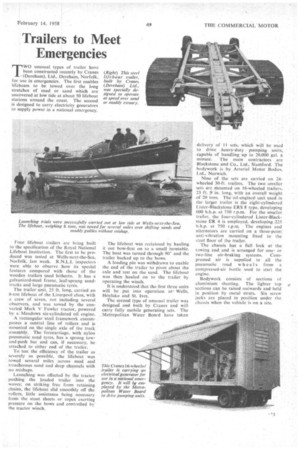Trailers to Meet Emergencies
Page 57

If you've noticed an error in this article please click here to report it so we can fix it.
T• WO unusual types of trailer have been constructed recently by Cranes (Dereham), Ltd., Dereham, Norfolk, for use in emergencies. The first enables lifeboats to be towed over the long stretches of mud or sand which are uncovered at low tide at about 50 lifeboat stations around the coast. The second is designed to carry electricity generators to supply power in a national emergency.
Four lifeboat trailers are being built to the specification of the Royal National Lifeboat Institution. The first to he produced was tested at Wells-next-the-Sea, Norfolk, last week, R.N.L.I. inspectors were able to observe how its special features compared with those of the wooden trailers used hitherto. It has a galvanized-steel frame, leaf-sprung sandtracks and large pneumatic tyres.
The trailer unit, 25 ft. long, carried an 8-ton lifeboat of the Liverpool class, with a crew of seven, not including several observers, and was towed by the converted Mark V Fowler tractor, powered by a Meadows six-cylindered oil engine.
A rectangular steel framework encompasses a central line of rollers and is mounted on the single axle of the track assembly. The forecarriage, with nylon pneumatic sand tyres, has a sprung towand-push bar and can, if necessary, be attached to either end of the trailer.
To test the efficiency of the trailer as severely as possible, the lifeboat was towed several miles across mud and treacherous sand and deep channels with no mishaps.
Launching was effected by the tractor pushing the loaded trailer into the waves; on striking free from retaining chains, the lifeboat slid smoothly off the rollers, little assistance being necessary from the stout sheets or ropes exerting pressure on the bows and controlled by the tractor winch. The lifeboat was reclaimed by hauling it out bow-first on to a small turntable. The boat was turned through 90° and the trailer backed up to the bows.
A loading pin was withdrawn to enable the end of the trailer to pivot about the axle and rest on the sand. The lifeboat was then hauled on to the trailer by operating the winch.
It is understood that the first three units will be put into operation at Wells, Hoylake and St. Ives.
The second type of unusual trailer was designed and built by Cranes and will carry fully mobile generating sets. The Metropolitan Water Board have taken delivery of II sets, which will be used to drive .heavy-duty pumping units, capable of handling up to 20,000 gal. a minute. The main contractors are Blackstone and Co., Ltd., Staniford. The bodywork is by Arterial Motor Bodies, Ltd., Norwich.
Nine of the sets are carried on 24wheeled 30-ft. trailers. The two smaller sets arc mounted on 16-wheeled trailers, 23 ft. 9 in. lone, with an overall weight of 20 tons. The oil-engined unit used in the larger trailer, is the eight-cylindered lister-Blackstone ERS 8 type, developing 600 b,h.p. at 750 r.p.m. Fort the smaller trailer, the four-cylindered Lister-Blackstone ER .4 is employed, developing 225 b.h.p. at 750 r.p.m. The engines and alternators are carried on a three-point anti-vibration mounting fixed to the steel Hoor of the trailer.
The chassis has a full lock at the towing end and is arranged for oneor two-line air-braking systems. Compressed air is supnlied to all the pneumatic road wh e e Is from a compressed-air bottle used to start the engine.
Bodywork consists of sections of aluminium sheeting. The lighter top 4. sections can be raised outwards and held in position by metal struts. Six screw jacks are placed in position under the chassis when the vehicle is on a site.




















































































































